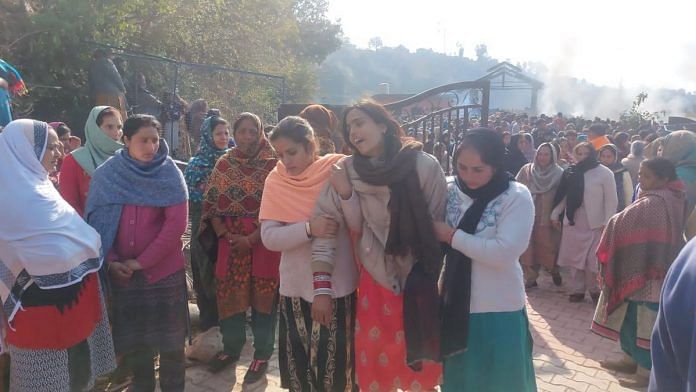Dhangri/Rajouri: For the first few seconds, the loud pops sounded like fireworks. But when the sounds came closer, 42-year-old shopkeeper Bal Krishan acted on instinct and grabbed the .303 rifle that had been gathering dust in his house in the remote village of Dhangri, roughly 10 km from Rajouri town in Jammu.
As he ventured into the dark Sunday night, Bal Krishan fired the old rifle for the first time in 24 years. As a former member of the now-defunct Village Defence Committee (VDC), a group of armed civilians, his old training kicked into gear. When he spotted two men with weapons emerging from a neighbour’s house, he trained the gun in their direction.
“I fired towards them and they ran away,” he told ThePrint, his mood somber. Like the rest of the village, he is in mourning.
The militants, who are believed to have infiltrated Dhangri at around 7pm from the nearby jungles, killed four people on the night of 1 January, including a father and son, and injured several others. Had it not been for Bal Krishan’s courage, the massacre might have been much worse.
The militants seemed to be on a mission, villagers said, to target Hindu families. As they went from house to house, four in all, they even checked the Aadhaar card of a male resident before firing. Had they not been chased away, villagers claimed the militants could have executed 70-80 people.
Yet, the carnage did not end there. On 2 January, an improvised explosive device (IED) that the militants had planted in a house went off, killing two minor girls and injuring 10 others. But here, too, there was a stroke of ‘luck’.
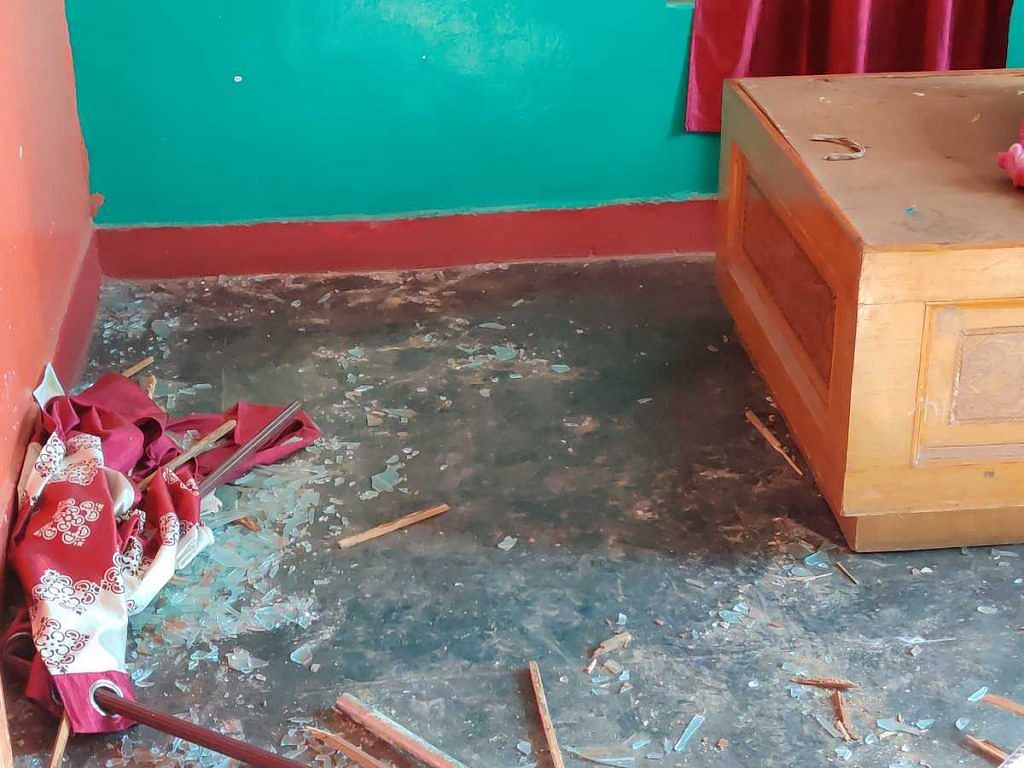
The explosion might have claimed 100-200 lives, locals said, if mourners had brought home the bodies of the shooting victims. At the time of the blast, the families of the deceased and other villagers had taken the dead bodies to Dhangri chowk, about 800 metres from the house where the IED was planted. They had gone there for a protest against the incident and alleged security lapse.
“In the two incidents, four people were brought dead and two others died while being treated. A total of 21 people were injured,” said Dr. Mehmood Bajar, medical superintendent at Rajouri’s Government Medical College (GMC).
He added: “All the injured are stable now. We have given the best possible treatment and a few people were also shifted to the Jammu GMC.”
In Dhangri, though, the bullet marks are still fresh and the wounds from the two back-to-back terror incidents will take a long time to heal.
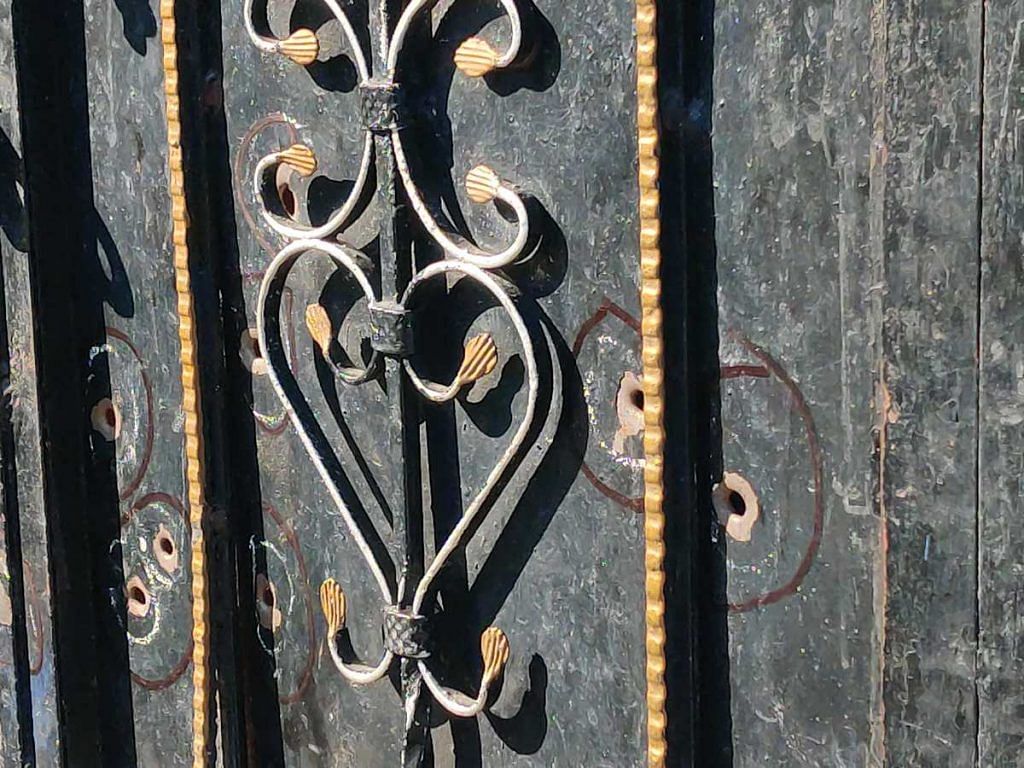
There was fear here when ThePrint visited this week, but also anger. Locals are upset that security agencies reached the spot only an hour and forty minutes after the firing, village sarpanch (head) Dheeraj Sharma said.
There is also anxiety over militancy again rearing its head in Rajouri. The town had witnessed numerous deadly attacks in the 1990s and 2000s. Given the remoteness and vulnerability of this region along the Pir Panjal range, there is a growing clamour to strengthen VDCs to help address the threat.
These civilian counterinsurgency groups comprising local residents and retired security personnel were first formed in Jammu region during the peak of militancy in Jammu & Kashmir in the 1990s. Trained by the security forces, VDC members played a key role in tackling the issue. There have, however, been allegations, including that of human rights violations, raised against VDCs.
As militancy receded, many VDCs were disbanded and some even had their weapons taken away by the administration. While the central government brought back what are now called Village Defence Groups last year, residents claimed that the scheme is yet to be properly implemented in the frontier districts of Rajouri and Poonch.
“Had Bal Krishan not fired, the whole of Dhangri would have been wiped out,” pointed out Ranjeet Tara, who was also a member of the same VDC. “We want the government to strengthen VDCs now.”
Also read: Pakistani militants bringing communal war back to J&K. Hindu killings in Rajouri are proof
‘Security forces failed us’
Until the Sunday attack, Dhangri residents felt safe going out of their houses even after midnight. But now, “it’s all quiet after 5pm”, said resident Rakesh Raina. “It’s the first time that such a horrific incident has happened in Dhangri. People are scared.”
Two major factors are heightening this fear. One is the targeted nature of the attack, which in the past have occurred more commonly in the Kashmir Valley than in Jammu. The Hindu families living here feel particularly vulnerable, they said, since they are in minority. According to the 2011 Census, Muslims constitute 62.71 per cent of Rajouri’s population.
The second issue is the perceived failure of the security apparatus, especially in the wake of the blast. Residents alleged that the security forces failed to sanitise the area properly after the Sunday attack, leaving the IED undetected.
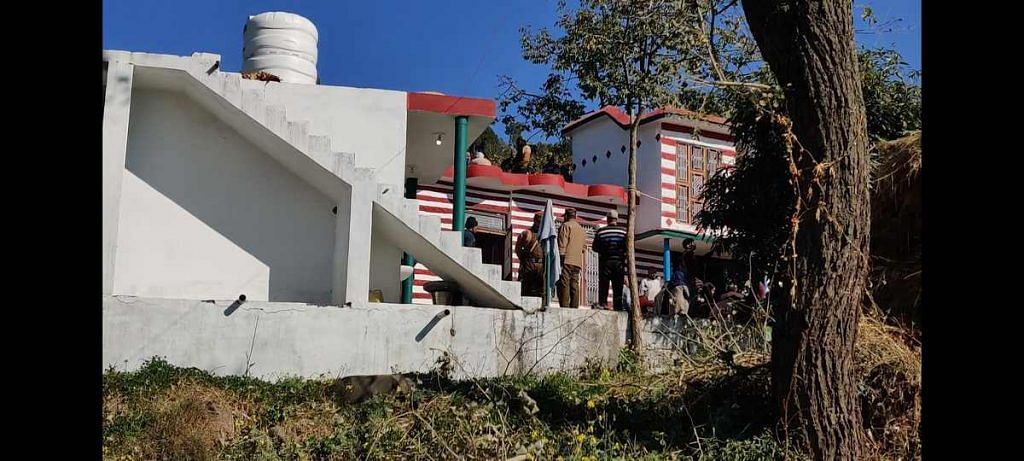
“It is a failure of security and intelligence forces. Four died in a terrorist attack at night, but the two children who were killed in the morning died in a murder. There was no search or sanitisation, which shows the extent of security failure,” alleged Harish Bhartiya, another Dhangri resident.
The father of one of the blast victims seemed unable to process what had happened. “My daughter and a niece died in the blast. When it happened, we [he and other villagers] were with the dead bodies (of the shooting victims),” the distraught man, who did not provide his name, said. “We have barely got any time to think about what the administration is doing to help.”
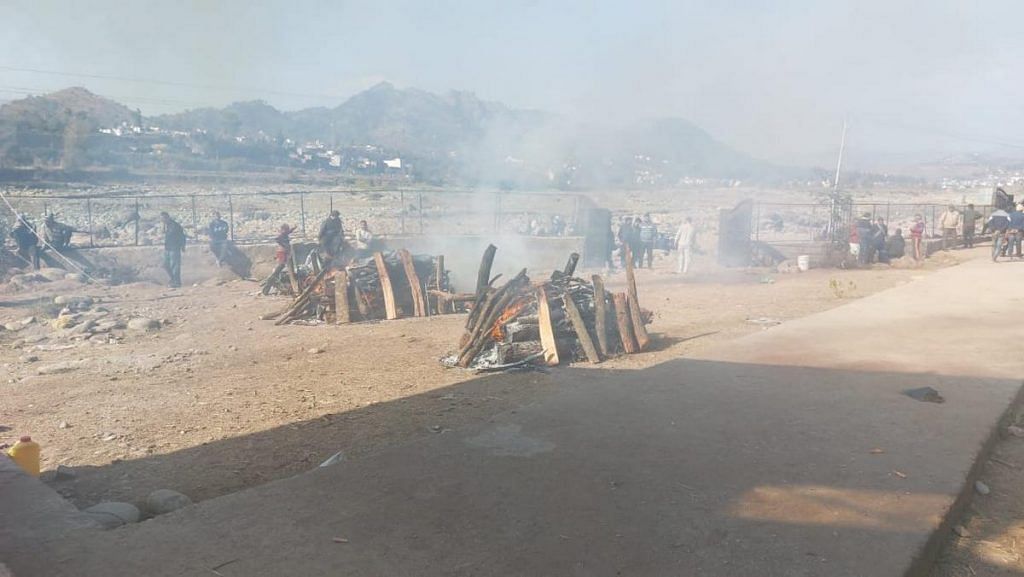
In a two-page statement, a copy of which is with ThePrint, protesting locals alleged that security personnel had failed to act on reports of militant sightings in the area. They also referenced the 16 December deaths in shooting of two civilians near the Alpha gate of the army camp in Rajouri.
“This massacre is a result of security officers who failed to terminate the militants who were seen roaming in Muradpur area thirty days before and most likely involved in shootout at Alpha gate, where two young civilians lost their lives. OGW (Over the ground workers) in these areas are clearly very active and helping different militant organisations,” the statement said.
Meanwhile, the CRPF has sent 18 more companies to Rajouri-Poonch districts in order to heighten the security of the region, ThePrint has learnt.
While the National Investigation Agency (NIA) has begun investigating the case, and search operations also continue across Rajouri and Poonch, a breakthrough is awaited.
“We will have to give them a befitting reply,” J&K director general of police (DGP) Dilbagh Singh had said after the incidents in Rajouri. “The IED blast was a planned attack aimed at targeting senior officers (who were to reach the site). The officers reached the spot late. The incident had happened already.”
Following the attack Lieutenant Governor Manoj Sinha announced an ex-gratia of Rs 10 lakh and a government job to the next of kin of the victims killed in the “dastardly attack”. Those “seriously injured” will be given Rs 1 lakh.
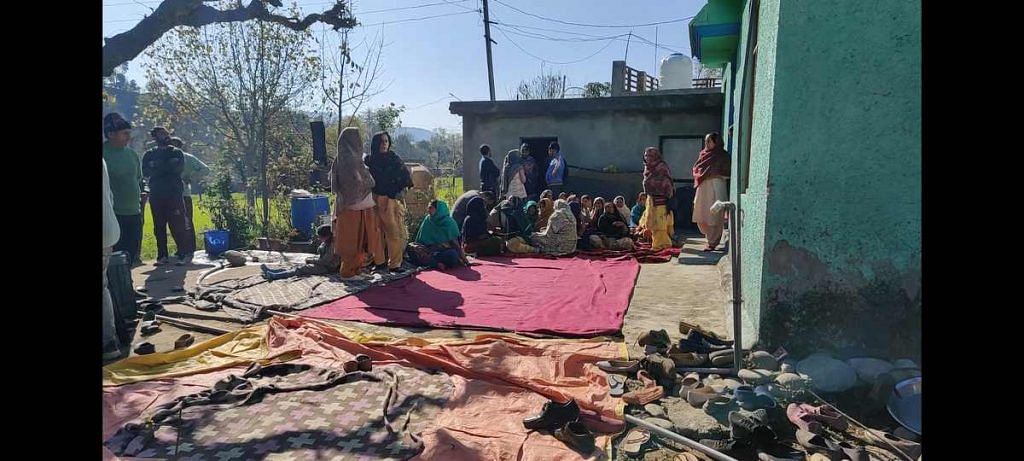
He also visited the protesting families Monday. Their demands included an assurance of strengthening VDCs, installation of CCTVs, FIR against officers involved in search and rescue operations, and compensation, among other things.
“It is our firm resolve to crush terrorists and the terror ecosystem,” the Lt Governor had said.
‘Unfortunately, we did not have guns…’
Meanwhile, Bal Krishan is a local hero in Dhangri, as is his .303 rifle, a weapon that the army had retired in the aftermath of the 1962 India-China war.
With militancy cooling over the years, the authorities took back the weapons of many VDC members, including some in Dhangri, said locals.
“Dhangri has been saved because of a VDC member. Therefore, we want the government to strengthen VDCs. People are also angry because guns of a few VDC members were taken back,” claimed VDC member Ranjeet Tara.
It’s an oft-repeated refrain here.
“Bal Krishan, a VDC member, touched his gun after a gap of many years and fired. He showed courage and saved nearly 60-70 lives. The direction in which the terrorists were going, things could have been much worse,” said resident Rakesh Raina. “Had the VDC been functional, they would have not even been able to enter the village. Unfortunately, we did not have guns.”
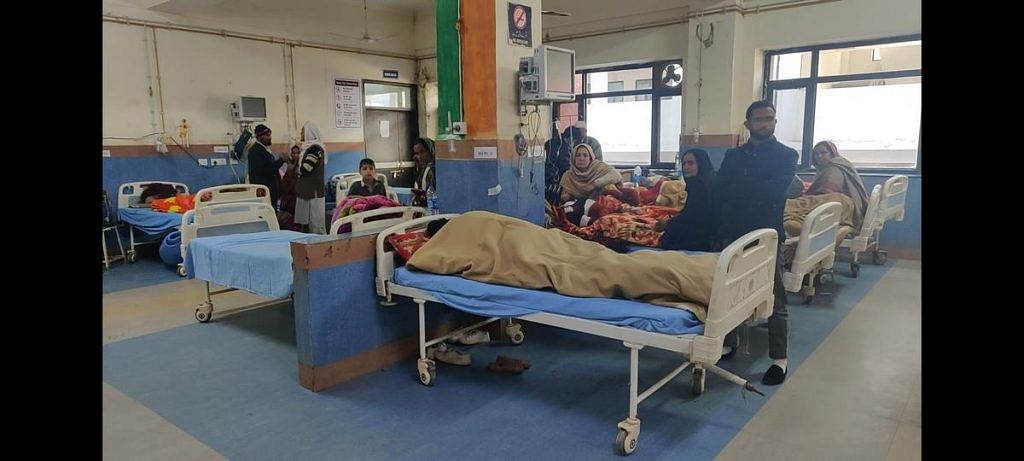
In March last year, the Union Home Ministry gave its nod to bringing back the VDCs, now known as Village Defence Groups under the Village Defence Guards Scheme, to help counter militancy with the help of armed civilians selected by the district administration. A few months later, in August, the scheme reportedly came into effect, but in Dhangri, the benefits are yet to be seen, claimed villagers.
According to sarpanch Dheeraj, the VDCs have not been active for some time now. “Had we had automatic weapons, those men wouldn’t have escaped,” he said.
Responding to concerns about the revival of VDCs, J&K DGP Dilbagh Singh had said Monday that the guns that had been taken back would be returned. “Wherever there is a need for more guns, they will be provided,” he added.
After a security review meeting with Army and police personnel, as well as the Dhangri sarpanch and families of victims, J&K Lieutenant Governor Manoj Sinha also emphasised that the administration would strengthen the VDCs.
Notably, despite the pivotal part they played in countering militancy, the VDCs have at times been associated with controversy. Over the years, various reports of misuse of weapons have emerged in different parts of Jammu. Last year in Poonch, a VDC member’s son reportedly took his own life using his father’s rifle. In another incident in 2015, demands were raised to disband VDCs after a committee member allegedly killed a woman and her four-year-old son in Rajouri district.
Growing threat of militancy?
While the mountainous border districts of Rajouri and Poonch in Jammu were largely free of militancy for over a decade, the last few years have seen a spike in incidents.
In 2022 alone, at least four incidents of militancy were reported in Rajouri district. In March-April last year, three blasts took place in Rajouri’s Kotranka town and Shahpur. In August 2022, two fidayeens were killed after they attacked an Army camp in Parghal village in Rajouri district. Four soldiers also died in the incident. Last month, two civilians in Rajouri were killed in a shooting outside an Army gate, although a magisterial probe has been ordered amid allegations that an Army sentry had opened fire in a case of mistaken identity.
Even back in 2019, after the police had busted a Hizbul Mujahideen drug smuggling nexus in Poonch district near the Line of Control (LoC), the district’s senior superintendent of police (SSP) had said that sleeper cells and overground workers were active in the region and were “trying to revive militancy”.
(Edited by Asavari Singh)
Also read: Behind Kashmir civilian killings, local men ‘made terrorists online less than 10-15 days earlier’


